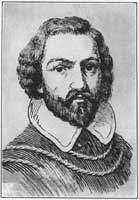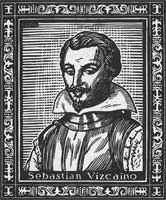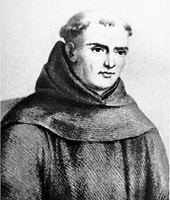Californias-Missions.org: Mission History (original) (raw)
The 16th Century was a period of discovery. Europe was emerging into the Renaissance and there was a renewed sense of excitement about what lay beyond the Oceans. Europeans and the people of Asia had started a rich trade route, but it was dangerous and took several months to travel to Asia and back. Spain also wanted to make their country bigger. Since Europe was already filled with countries and people, the King decided to expand his country by colonizing, moving Spanish citizens, into areas of the New World.
The Spanish were skilled sailors and explorers, they had already �discovered� the Americas and the King of Spain decided it would be a good idea for Spain to travel to the West again to see if they could find a quicker route to Asia and locate land for Spain to claim.
Hernan Cortez had traveled from the Caribbean to Central America and conquered the Aztecs, a very large and strong civilization in what is now Mexico. Spain named their new country New Spain and with this foothold on the continent Spain planned to travel further north. Other explorers such as Coronado and Cabrillo had both explored the west coast and didn�t find riches like those from the Aztecs. Spain focused on colonizing and building the number of people, or population, in New Spain instead.
 Juan Cabrillo had served in Cortez� army and was given the task of sailing up the Pacific Coast of North America to find what mapmakers from the day thought was a river from the Atlantic Ocean to the Pacific Ocean and to discover new lands for Spain. We know now that there isn�t a river that runs between the two coasts, but the maps of the day were incorrect. Cabrillo and his crew sailed from the town of Navidad in New Spain on June 24, 1542. It took Cabrillo and his crew over three months to reach what would become the first port in Alta California. He named the port San Miguel, the name was changed years later by another explorer, Sebastian Vizcaino to the name it holds today, San Diego.
Juan Cabrillo had served in Cortez� army and was given the task of sailing up the Pacific Coast of North America to find what mapmakers from the day thought was a river from the Atlantic Ocean to the Pacific Ocean and to discover new lands for Spain. We know now that there isn�t a river that runs between the two coasts, but the maps of the day were incorrect. Cabrillo and his crew sailed from the town of Navidad in New Spain on June 24, 1542. It took Cabrillo and his crew over three months to reach what would become the first port in Alta California. He named the port San Miguel, the name was changed years later by another explorer, Sebastian Vizcaino to the name it holds today, San Diego.
Cabrillo�s expedition continued up the California coast, discovering other wonderful harbors including one that what would eventually be named the Monterey Bay, because of thick fog, though, they sailed by the San Francisco bay without seeing it.
The journey was difficult due to bad weather and heavy seas. Cabrillo died 6 months after sailing from New Spain from injuries he received during the journey.
 The King of Spain tried again 60 years later and sent Sebastian Vizcaino to find the water route. Vizcaino failed also, but heard that ships from Russia, Portugal, and England had visited the coast. Spain was concerned that England and Russia might try to settle the land and claim it for themselves. Occupying a land is one way to keep others off of it. Russia had already come down the Pacific Coast from the northern coast of Alaska and had settled at Fort Ross in Bodega Bay north of what is now San Francisco. The Russians had come to California to hunt sea otters for their skins, called pelts. Colonizing the coast would also allow Spanish trade ships from Asia safe harbors with food and supplies on their way back across the Pacific Ocean so the King�s ministers devised a plan to settle the area using Missions which would help convert the native peoples and make them into citizens of Spain.
The King of Spain tried again 60 years later and sent Sebastian Vizcaino to find the water route. Vizcaino failed also, but heard that ships from Russia, Portugal, and England had visited the coast. Spain was concerned that England and Russia might try to settle the land and claim it for themselves. Occupying a land is one way to keep others off of it. Russia had already come down the Pacific Coast from the northern coast of Alaska and had settled at Fort Ross in Bodega Bay north of what is now San Francisco. The Russians had come to California to hunt sea otters for their skins, called pelts. Colonizing the coast would also allow Spanish trade ships from Asia safe harbors with food and supplies on their way back across the Pacific Ocean so the King�s ministers devised a plan to settle the area using Missions which would help convert the native peoples and make them into citizens of Spain.
Spain had already established settlements in what is now Mexico (Baja California and New Spain), Florida, and Texas and as far south in Central American to Guatemala. Spain had learned from its conquering of the Aztecs what to do and not to do when trying to take over a people�s land. King Carlos had two main reasons for establishing Missions. The Missions helped Christianize the natives which made them Catholic converts, or neophytes, for the Catholic Church and citizens of the crown of Spain.
Spain was a Catholic country. That means that they followed the teachings of the Catholic Church. Within the Catholic Church it was divided into different groups. Three main groups, the Jesuits, Franciscans, and Dominicans were involved with the colonization of Alta and Baja California.
King Carlos allowed the Jesuits to found and run the Baja California Missions but in June 1767 they were transferred to Franciscan control. The Spanish government thought the Jesuits were becoming too powerful. The Jesuits had been given control over the missions and the soldiers that lived at the military forts or presidios. Spain decided that the Franciscans would still have control over the running of the missions, but that they would not be in control of the soldiers.  The Franciscans sent Father Junipero Serra to found the first Alta California Mission. His goal was to reach the harbor that Cabrillo had found and named San Miguel and that Vizcaino had claimed for Spain under the name of San Diego. Father Serra and the Governor of New Spain decided to split the expedition into groups that would go by land and by sea. Three ships, the San Carlos, San Jose, and San Antonio sailed during the first six months of 1769 and two groups of soldiers and priests went overland. It was a difficult trip and many men died; the San Jose was lost at sea--no one on the ship survived. The sea routes were very important, and that is why most missions are near the coast, the mountain ranges and deserts in Alta California made it difficult to reach the coast from inland.
The Franciscans sent Father Junipero Serra to found the first Alta California Mission. His goal was to reach the harbor that Cabrillo had found and named San Miguel and that Vizcaino had claimed for Spain under the name of San Diego. Father Serra and the Governor of New Spain decided to split the expedition into groups that would go by land and by sea. Three ships, the San Carlos, San Jose, and San Antonio sailed during the first six months of 1769 and two groups of soldiers and priests went overland. It was a difficult trip and many men died; the San Jose was lost at sea--no one on the ship survived. The sea routes were very important, and that is why most missions are near the coast, the mountain ranges and deserts in Alta California made it difficult to reach the coast from inland.
The Franciscan Missionaries had a book of �rules� written by Spain from what they had learned about founding the other missions. The book included info on how to entice natives to join the missions, what the daily schedule should be, and other details. With the rules in mind Father Serra founded Mission San Diego de Alcala in 1769 and began the Spanish colonization of Alta California. Father Serra established 9 missions before his death and burial at Mission San Carlos. Eventually 21 Missions were built in the 54 years between 1769 and 1823 in a chain that stretched from its southern edge in San Diego to north of the San Francisco Bay.